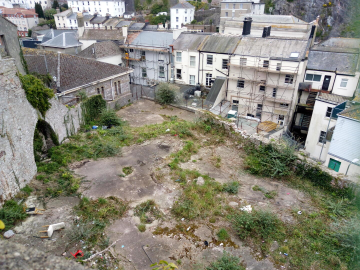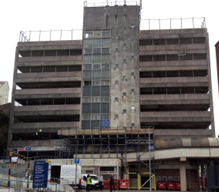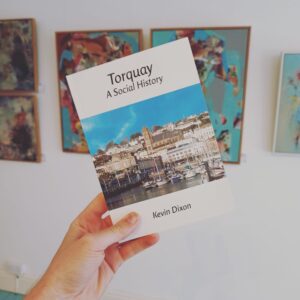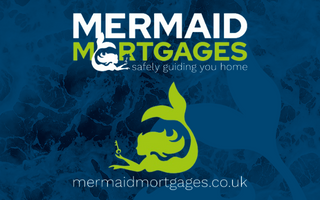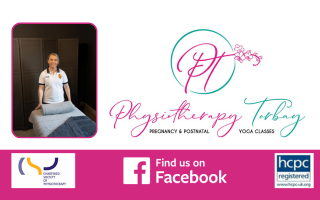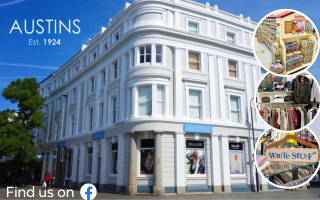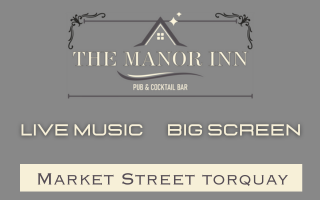In 1892 Torquay was granted borough status by Royal Charter.
The resort then adopted the motto ‘Salus et Felicitas’, or ‘Health and Happiness’, so identifying its offer to both visitors and residents.
Torquay’s motto ‘Salus et Felicitas’, or ‘Health and Happiness’
The maxim explained the town’s origins and intent and proclaimed its successes. It also unintentionally predicted what would become Torquay’s future challenges. And, as we know, history has the tendency to repeat itself.
Torquay began as a place for the sick and dying.
Back in 1830 Dr. Clark informed the nation that the growing town “possesses all the advantages of the South-Western climate in the highest degree” for the treatment of Consumption. The following year the Irish surgeon James Johnson wrote a very successful book which recommended visiting health-giving resorts.
The town’s offer was relief from Consumption, a wasting away of the body particularly from pulmonary tuberculosis (TB). This infectious disease generally affected the lungs. It was Britain’s biggest killer and called ‘The White Death’.
And they came in their thousands, to be cured, to recover, and perhaps to stay in our hospitals. Inevitably some didn’t regain their vigour and lie in the churchyard at Torre.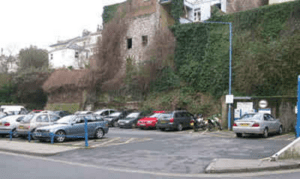
Torquay town centre, unloved and abandoned
This new health industry rapidly reshaped a scatter of ancient rural hamlets. In 1840 Dr Granville reported that, “The Frying Pan along the Strand is filled with respirator-bearing people who look like muzzled ghosts, and ugly enough to frighten the younger people to death”.
After the arrival of the railway in 1848 Torquay was again transformed, this time into a more open tourist resort.
Hosting all those wealthy visitors were the finest hotels and its famed five-hundred villas. Torquay was indeed designed for prosperous incomers. It was also shaped by their servicing which brought in thousands of workers, many of them female. In 1881, for instance, there were 13,665 males in Torquay, outnumbered by 19,293 females.
By the beginning of the twentieth century the resort was claiming to be the richest town in the nation. It consequently deserved its new town hall, a gleaming Pavilion, and even an opera house.
That emphasis on holidaymaking has left a legacy beyond premium architecture.
By purposely excluding other forms of industry, tourism’s domination of the town saw employment focussed on low-paid, insecure and seasonal work. This led to a stark division between the wealthy elite and the servile class. When Canadian Isabella Cowen visited in 1892, she was shocked, “I have seen more luxury since being in Torquay than in all my previous life, and I know I never saw such pitiable poverty before.”
Inequality remains, with Torbay’s economy ranked among the weakest in the nation. The median annual wage in our three towns is £27,116, the third lowest in the UK. In contrast, Devon’s best-paid workers are in Exeter, just 24 miles away, where the wage is £33,375; £7,000 higher than it is in the Bay.
Recently inequalities have been widening. Those in our most deprived areas now have a life expectancy on average over eight years less when compared to the more affluent parts of the Bay.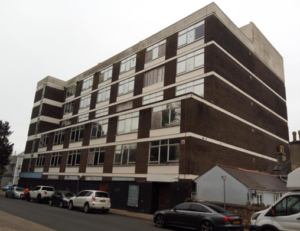
Roebuck House on Warren Road, empty for a decade when 1600 are on the housing waiting list
Even our successes, though, can bring their own challenges.
One of Britain’s great achievements is that we are now living far longer than we used to. For much of human history average life expectancy was about thirty years of age. During the nineteenth century only around half of people born made it past their fiftieth birthday. Even during the 1950s life expectancy was only 66 for men and 70 for women.
A boy and girl born in Torbay in the early 2020s now have a life expectancy of 78 and 83 years respectively.
This increase can be attributed to improvements in public health, nutrition and medicine. Vaccinations and antibiotics have greatly reduced deaths in childhood, while health and safety in workplaces have improved and now fewer people smoke.
While such longevity is much to be welcomed, the lure of the Bay ensured that, that alongside being a tourist destination, our three towns appealed to the retired incomer.
We now have an older age profile than the rest of the nation, an average age of 49 years compared to 40 years across the UK. 27% of Torbay residents are now aged 65 and over. Within a decade it is predicted that one in three Torbay residents will have reached that age; this is already the case in Wellswood, Churston, Galmpton, Furzeham, and Summercombe.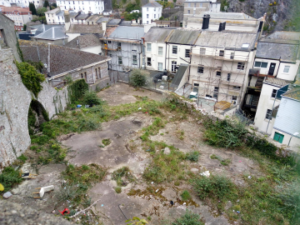
The laundry site on Rock Road, awaiting a new use for decades
At the same time, the number of us who are of working age is projected to fall to approximately half of the population from its current rate of 55%.
Though we may be living longer, for many the quality of life enjoyed can be relatively poor. Of course, not all the retired are wealthy or healthy with one in four residents having conditions or illnesses that reduce their ability to carry out day-to-day activities; while others report low levels of life satisfaction, anxiety, or loneliness.
This all clearly has significant implications for the provision of health, social care and for the revenue that can be collected from residents and businesses. Torbay already has far higher levels of need that require support from Adult Social Care when compared to the rest of the nation. This demand will only increase, maybe putting intolerable strain on services.
At present, for example, people are taking up residence in the Bay’s 73 care homes 4 years earlier that they do in other parts of the UK. Perhaps they struggle with day-to-day tasks such as cooking and cleaning, when technology, support and community networks could enable them to stay independent for years longer.
At the same time the local birth rate is falling. The required replacement fertility rate is 2.1 children per woman. Torbay’s rate is 1.4, meaning that the population should be falling.
It isn’t.
The Lower Union Street car park, unloved, underused, and avoided by many
Torbay’s population is projected to rise from 139,000 now to over 153,000 over the next 20 years. To meet this demand, government housing targets decree that nearly 1,000 new homes must be built in Torbay every year.
What is driving population increase are incomers, often older people from other parts of the UK. And we are already importing many workers to support the elderly and infirm, essential health and care staff that will inevitably come from beyond the British Isles.
Yet sometimes solutions to present and future problems can be found by looking backwards.
During the nineteenth and twentieth centuries, technology, new types of leisure and employment, and a growing population, created an infrastructure and architecture that transformed Torquay into a new kind of place.
The town centre changed, relocating its inhabitants to the suburbs, shifting the backstreet small industries, workshops and pubs, and replacing them with chain stores, offices and car parks.
The town centre was once a place of high density communities using local shops, pubs, cafes and entertainment
We may now have forgotten that those old parts of town – Pimlico, Swan Street, Temperence Street, Melville Hill – used to be home to thousands in close-knit high-density communities, close to shops, entertainment and neighbourly support.
So, if we must build on an unprecedented scale, let’s reoccupy our town centres and go back to the future to create communities that enable people to stay in their own homes as long as they can. How about utilising derelict land, replacing empty office space and underused town centre car parks, with hundreds of supported apartments for older people, so freeing up larger suburban homes for families.
The alternative is to continue encroaching on our green field sites until none remain.
To really make the Bay healthier and happier we all need a healthy diet, exercise, good mental health, and a sense of community and belonging. Regeneration of our town centres would be a good start in reimagining what the Bay could offer in the future.
‘Health and Happiness’ was Torquay’s motto in an age when the resort was a leisure centre of Empire. For many of us, this is now satire. However, it could be a reality once again if we reinvigorate our often-troubled urban centres to meet the challenges and opportunities of the coming decades.
Torquay: A Social History’ by local author Kevin Dixon is available for £10 from Artizan Gallery, Lucius Street, Torquay, or:
https://www.art-hub.co.uk/product-page/torquay-a-social-history-by-kevin-dixon


